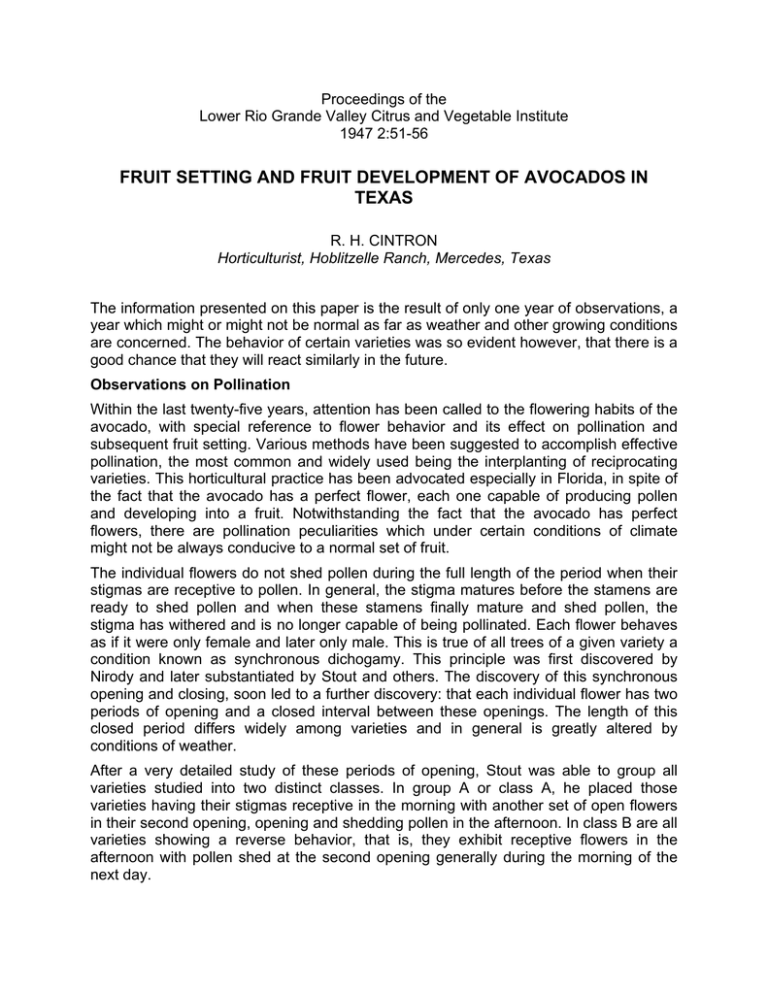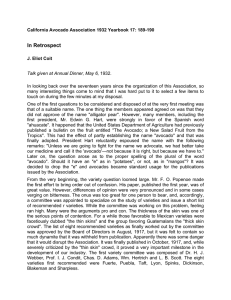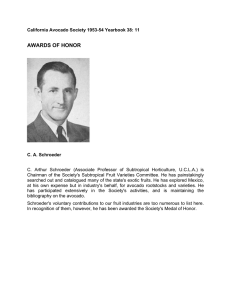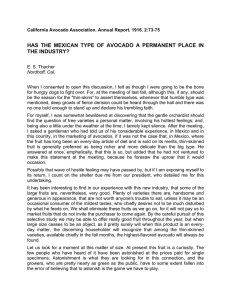FRUIT SETTING AND FRUIT DEVELOPMENT OF AVOCADOS IN TEXAS
advertisement

Proceedings of the Lower Rio Grande Valley Citrus and Vegetable Institute 1947 2:51-56 FRUIT SETTING AND FRUIT DEVELOPMENT OF AVOCADOS IN TEXAS R. H. CINTRON Horticulturist, Hoblitzelle Ranch, Mercedes, Texas The information presented on this paper is the result of only one year of observations, a year which might or might not be normal as far as weather and other growing conditions are concerned. The behavior of certain varieties was so evident however, that there is a good chance that they will react similarly in the future. Observations on Pollination Within the last twenty-five years, attention has been called to the flowering habits of the avocado, with special reference to flower behavior and its effect on pollination and subsequent fruit setting. Various methods have been suggested to accomplish effective pollination, the most common and widely used being the interplanting of reciprocating varieties. This horticultural practice has been advocated especially in Florida, in spite of the fact that the avocado has a perfect flower, each one capable of producing pollen and developing into a fruit. Notwithstanding the fact that the avocado has perfect flowers, there are pollination peculiarities which under certain conditions of climate might not be always conducive to a normal set of fruit. The individual flowers do not shed pollen during the full length of the period when their stigmas are receptive to pollen. In general, the stigma matures before the stamens are ready to shed pollen and when these stamens finally mature and shed pollen, the stigma has withered and is no longer capable of being pollinated. Each flower behaves as if it were only female and later only male. This is true of all trees of a given variety a condition known as synchronous dichogamy. This principle was first discovered by Nirody and later substantiated by Stout and others. The discovery of this synchronous opening and closing, soon led to a further discovery: that each individual flower has two periods of opening and a closed interval between these openings. The length of this closed period differs widely among varieties and in general is greatly altered by conditions of weather. After a very detailed study of these periods of opening, Stout was able to group all varieties studied into two distinct classes. In group A or class A, he placed those varieties having their stigmas receptive in the morning with another set of open flowers in their second opening, opening and shedding pollen in the afternoon. In class B are all varieties showing a reverse behavior, that is, they exhibit receptive flowers in the afternoon with pollen shed at the second opening generally during the morning of the next day. If this synchronization were not altered, it is clear that isolated plants, or plants within a variety, or varieties within the same group, would not set fruit unless pollen were available from varieties belonging to a reciprocating group. Florida growers have been the most enthusiastic exponents of the need of interplanting these two groups. This practice has been going on in spite of several observations by experienced growers who have repeatedly noticed and experienced adequate fruit setting in isolated trees and in solid plantings. Such repeated observations have made many of them skeptical of the need of interplanting reciprocating varieties in spite of the fact that need for it as indicated by flower studies. The practice is still advocated and followed to a large degree in that state. They can point, to be sure, to some cases where fruit setting has been increased by providing the proper pollinator. California growers, on the other hand, have been harder to convince of this need. They have many solid blocks, especially of the Fuerte variety which have been productive without the apparent need of a reciprocating variety. There, it is not a grower's practice to plan their orchards with that extra problem on their minds. In California, in Florida and now in Texas, it has been observed that the opening and closing cycles of the avocado flowers are often upset by violent weather changes. This results in "overlap" of the two sets of flowers. If insects are active and the overlapping period is not too short, considerable close pollination may occur. While located at Mercedes, and during the winter and spring of this year, your speaker made frequent observations on the flower behavior of the avocado. Mexicans, MexicanGuatemalan hybrids, Guatemalan and West Indian varieties were represented. In every variety studied, considerable overlapping was observed. This, coupled with a very abundant and active insect life, resulted in a satisfactory set of fruits. It is true that at the Hoblitzelle Ranch where the most detailed observations were made, eleven varieties are growing nearby, some of each of the two groups. The Fuerte and Duke, however, were early bloomers and set fruit during the last week of February, at a time when no other variety was furnishing pollen. Since both varieties belong to the same group, it must be concluded that the set of fruit observed must have been the result of pollination during the overlapping period. In fact, considerable overlap was observed in both varieties. At LaFeria, a planting of Lulas was blooming at a time when the only available pollen (aside from its own), must have been coming from the very tail end of the bloom of three Fuerte trees. The major portion of the planting, however, was blooming when no Fuerte flowers could be found, yet these trees showed a heavy set and to the present time are carrying a good crop. Recognizing the fact that sudden changes in the weather will upset the synchronous opening and closing of the avocado flower resulting in considerable overlap, and assuming that the changeable weather observed during the winter and spring of this year, represent normal weather changes for the Rio Grande Valley, it can be concluded that under our conditions, deficient pollination will not be a major factor in fruit setting. We must recognize a difference in the ability of a variety to set and the ability to hold and mature a reasonable portion of the young fruits. In the light of this year's observation, our problem with certain varieties will not be a pollination problem or one of fruit setting. The problem will be that of getting the young fruits to stay on the trees and growing to maturity. Several factors have been recognized as contributing to excessive shedding of young fruits. Two factors are of paramount importance. Unfavorable water relations, especially a moisture deficiency, will cause abundant dropping. We are eliminating this factor as a cause of unfruitfulness of some varieties because in a planting consisting of several varieties all trees were watered identically and in every respect each tree was treated in the same way. Yet some varieties dropped all their fruits while others matured a good crop. Sudden heat waves especially when the fruit is small, will also cause excessive shedding. Mexican varieties here will set in February, while other varieties of the West Indian and Guatemalan groups will set in March and April. The mean temperature during March was 67.3 degrees with maximum and minimum averages of 80.4 degrees and 54.2 degrees respectively. The mean temperature for April was 76 degrees with a maximum and minimum average of 86.1 degrees and 65.9 degrees respectively. These averages, however, do not present the entire picture. From the fourth to the tenth of April, the maximum temperature was in the lower 90's. Strong drying winds were prevalent during this period. Excessive dropping in most cases up to 100%, occurred in the Edranol, Ryan, Helen and Leucadia varieties. In May the average of the maximum temperature was 96 degrees with several real hot days and strong drying winds. The Nabal dropped every fruit during the first hot days of May. The Duke, Jalna, Fuerte, Lula and many West-Indian seedling trees, did not suffer much and any dropping observed can be considered normal. It is apparent, therefore, that some varieties are more sensitive than others to dry hot winds. Guatemalans and Guatemalan-Mexican hybrids appear to be affected the most. The Fuerte, a supposedly Guatemalan-Mexican hybrid, did not behave as other hybrids. These facts must be recognized if an intelligent selection of varieties for this Valley is to be made. The Nabal, a Guatemalan variety, and the Ryan a Guatemalan-Mexican hybrid exhibited a very peculiar behavior. During their blooming period both varieties shed their leaves to an appreciable degree. Vegetative growth was resumed very soon after the fruit was set. Soon after this, an excessive shedding of young fruits was observed. It cannot be determined with certainty if the dropping was due to the high temperatures while the fruit was small or to a partial starvation of the tree due to an excessive demand from the vegetative organs. It should be pointed out here that varieties which were able to mature a good crop did not defoliate appreciably previous to fruit setting. Also puzzling is the fact that the Leucadia variety, a supposedly Mexican, was able to retain its foliage during the blooming period, yet very early they dropped their fruits altogether. Its reaction is not that of a typical Mexican. Likewise, the fruiting habits and character of growth of the Lula, suggest a West-Indian Guatemalan hybrid and not a Guatemalan-Mexican cross it has been considered up to the present time. Fruit Growth and Development Under Rio Grande Valley weather conditions, fruit growth and development is very rapid. The Mexican varieties which normally set fruit in February, will attain maturity as early as the middle of June. Fuertes will begin maturing late in August. Ryans can be picked in October. Both varieties have large sizes by this time. West Indian seedlings will attain maturity and very large size in six months. Hot days and warm nights all through the summer, keep the fruit growing all the time. It is discouraging to find, however, that while the fruit is growing at such a rate, oil formation is not keeping pace with fruit growth. Periodical oil determinations conducted as the fruit approached and attained maturity, showed in general that oil content is very low. This is true for West Indian as well as for selected Mexican and MexicanGuatemalan hybrids known to be high in oil when growing under California conditions, for example. This low oil content in fruit physiologically mature, eliminates the practicability of .using the oil test as a measure of maturity. In other words, if the fruit softens properly and drops from overmaturity while the oil content is still at a very low level, some other practical and easy method to test maturity must be found. Table 1 presents data on four Mexican Varieties tested at different periods. Tests started July 1 4th when the writer obtained a Bauch & Lomb refractometer for this purpose. These tests continued while fruit was still available. It is evident from a study of this table that these varieties will not develop enough oil when maturing under our conditions. Table II presents data for the Fuerte variety. It can be seen that up to the present time this variety is not developing oil to a satisfactory level in spite of the fact that the fruit is completely mature. This particular variety is still available and oil determinations will continue. It will be interesting to follow the formation of oil as the fruit develops through cooler weather. Three West-Indian seedlings were also tested at different periods. As expected, their oil content was low, the highest showing 7.51% oil. Lula was tested March 24th, 1947, after being on the tree for fully twelve months. Under Florida conditions this variety will have between 8 and 12% of oil. Here it showed 7.75 percent. Ryans were also tested March 24th. It also had been for twelve months on the tree. That analysis showed 16.3% oil. Under California conditions, this variety averages 25% oil. It was also observed that under Texas conditions, avocado varieties not only will show a low oil content, but also the picking season is greatly shortened. The fruit drops very fast with approaching maturity and must be picked at very short intervals and during a short season. This is especially true of all Mexican and West-Indian varieties. Of the varieties observed, only Guatemalan-Mexican hybrids such as the Lula and the Ryan and to some extent the Fuerte, will stay on the trees for a longer time. Summary and Conclusions There is evidence to support the belief that under our conditions, there is enough overlapping to insure selfing of the avocado flower. There is no apparent need, therefore, of interplanting reciprocating varieties. Fruit drop is very pronounced in certain varieties in some cases making them entirely unsatisfactory. Guatemalan varieties seem to be affected the most. In view of this fact, it is doubtful that the better types of straight Guatemalan varieties will ever be fruitful enough to be considered desirable for this region. All varieties representing the three types of avocados, West Indian, Mexican and Guatemalan show low oil content when grown under our condition. It appears in general that high oil content is more a response to low mean temperatures during fruit development than a specific varietal characteristic. All observations point to the belief that due to the low oil content of most varieties when grown under our conditions, the oil test will not be practicable as a measure of maturity. Some other method must be found to accomplish this need.


